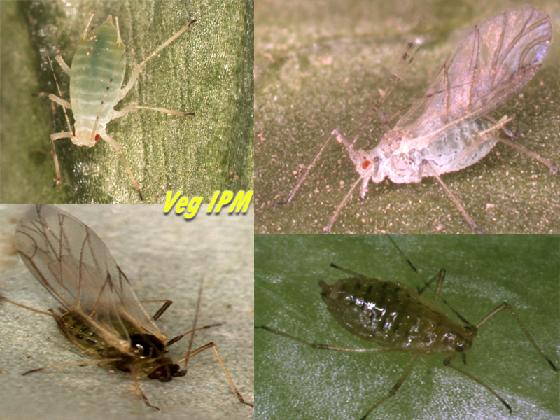 |
|
|
|

|
|||
| |
|||
In a recent update (Nov 16, Vol 2, No. 23), we anticipated that PCAs would soon begin finding aphids infesting local lettuce and cole crop fields. Well, last week we readily found both winged (alate) aphids, as well as small colonies of apterous (wingless) green peach aphids, Myzus persicae, on untreated lettuce plants at the Yuma Ag Center. Timing of aphid colonization in lettuce and other leafy vegetables varies by species, and depends largely on temperature, rainfall and planting dates. For example, previous studies suggest that green peach aphids are historically most severe on late October and early-mid November plantings of lettuce. By late February green peach aphid populations generally begin to rapidly decline as temperatures increase. However, this is not always the case on other crops such as cabbage and spinach where we've also observed heavy green peach aphid infestations occurring on these crops in late March and early April. Other aphids such as foxglove and lettuce 'red' aphid typically cause problems on later lettuce plantings (i.e., late November and December) because these species are better suited to warmer winter temperatures. However, there are exceptions to the rule and aphids can occur when least expected. For more information on aphid population dynamics on desert lettuce see the aphid dynamics report. It's important to also note that in our inspection of lettuce plants last week, field plots that had been treated with a soil, at-planting application of imidacloprid (Admire Pro, 7 oz) were aphid free. This is not surprising since imidacloprid at the 0.25 lbs a.i./acre rate still provides long residual control of most aphids (less consistent on foxglove and lettuce aphid). Research trials from last spring showed that imidacloprid soil applications in head lettuce provided protection against aphid contamination nearly season-long. In many cases, an application of a foliar alternative is generally required near harvest to prevent unacceptable aphid contamination. The trick is to determine when the imidacloprid residual begins to decline and aphids begin to colonize. Of course, this will require close examination of heads well in advance to harvest. Remember: "when in doubt, scout". Aphids To contact John Palumbo go to: jpalumbo@ag.arizona.edu
|
|||
| Back | |||
For questions or comments on any of the topics please contact Marco Pena at the Yuma Agricultural Center. |
|||
| Home | Cotton
| Veggies | Forages
| Grains | Citrus
| Crop x Crop Insects | Diseases| Weeds | Pesticides | Economics | News | Weather | Research | Photos | Contacts | General Info. Copyright © 2001 University of Arizona, College of Agriculture and Life Sciences Webmaster: Al Fournier (acis@ag.arizona.edu) |
|||
